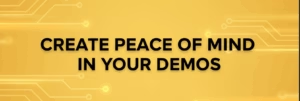Great Demos Stimulate Conversations and Naturally Last Longer
Ask yourself: How much time did you spend on your last demo? Was it 60, 90, or even 120 minutes?
Many of my clients wonder about the ideal length for a software demo. There’s no one-size-fits-all answer. It depends on the type of demo you’re giving. For a first discovery session, you’re usually looking at less than 20 minutes. If you’re in the final stages of the sales cycle, a more detailed demo might take longer, as you need to cover all the important points.
The complexity of your solution also plays a role in how long the demo lasts. Managing that complexity is key to a successful demo. Thankfully, we have some benchmarks to help guide you.
Successful Demos take around 47 Minutes
Gong.io, a company that uses AI to analyze sales conversations, looked at over 67,000 software demos to find patterns in successful presentations. Their findings give us clear insights that you can apply to your own demos:
- 47 minutes is the average length of a winning software demo.
- 36 minutes is the average for less successful demos.
This doesn’t mean you should talk for 47 minutes straight. But it shows that longer demos often lead to more success. Why? Because they spark conversations that address the prospect’s pain points and make them feel excited about your solution.
According to Gong.io, the reason longer demos succeed is simple: they’re more fun, engaging, and exciting. Great demos resonate with your audience, keeping them interested and naturally extending the session. When you hit the right points, your prospect will want to spend more time with you and your product.
Great Demos result in Dialogues that naturally last longer
Successful demos evolve from a one-sided presentation into a two-way conversation. The more engaged your audience, the more hooked they are on your value proposition. Gong.io found that questions increase by 36% in the second half of winning demos. In less successful demos, there’s far less interaction, and as a result, the session ends sooner.
Don’t worry if it takes a little while to get your audience talking. Start by asking them questions about how they currently manage their processes without your solution. Aim to check in with your audience every 50-70 seconds to keep things interactive.
Personally, I’ve had plenty of demos where the audience started out reserved and hesitant. They kept their thoughts to themselves, not showing any emotion. But the longer we talked, the more engaged they became. They started sharing their thoughts because the stories I told resonated with their daily struggles. They could see how our solution would fit into their lives. Remember, engagement tends to increase during the second half of the demo.
But one tip: don’t ever ask, “Does that make sense?” It’s one of the most common mistakes, and it’s really just an empty phrase that shows you’re unsure if your feature has value. Instead, ask questions that provoke thought, like, “Have you ever considered doing it this way?” This keeps the focus on the benefits of your solution and why they matter to your audience.
Don’t be afraid of questions—questions are a great sign that your demo is working. They show that your audience is engaged and interested.
To sum up: Winning demos naturally last longer because your audience sees the value in your solution. This sparks discussions, helping them realize on their own how your product can improve their life. Once they’re hooked, they’ll want to spend more time exploring your solution.
But be careful. Don’t just schedule a long demo for the sake of it. If you’re not providing value, both you and your prospect will end up wasting time. Plus, it’s hard to hold someone’s attention for two hours if you’re not delivering continuous value throughout the demo.





